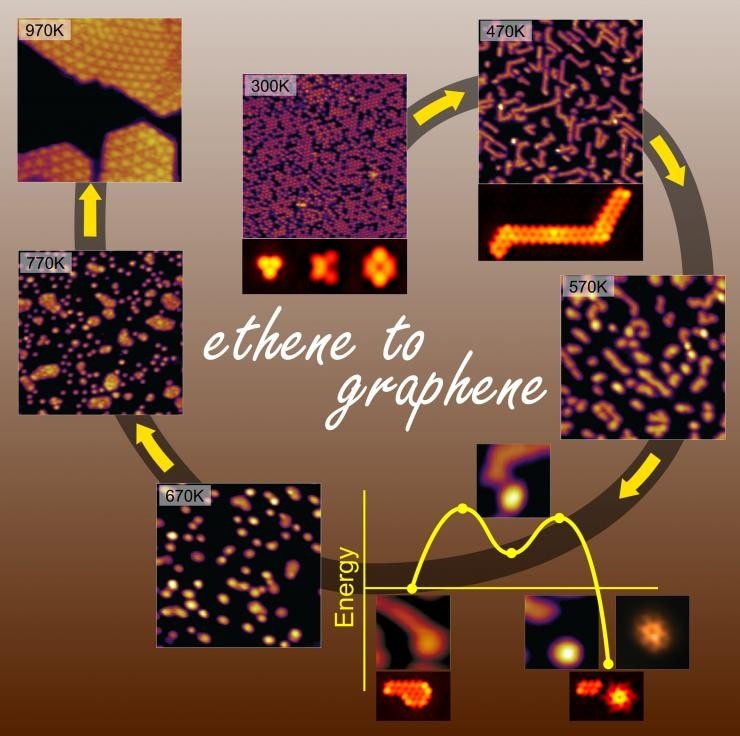May 5 2017
 Measured and theoretically simulated images of stages in the dehydrogenation process observed in programmed surface heating experiments. The sequence starts from adsorbed ethene (at 300K), leading to self-evolved 24-carbon-atom cluster precursors (between 570K and 670 K), and culminates with graphene formed at elevated temperatures (between 770K and 970K). CREDIT: U. Landman and B. Yoon.
Measured and theoretically simulated images of stages in the dehydrogenation process observed in programmed surface heating experiments. The sequence starts from adsorbed ethene (at 300K), leading to self-evolved 24-carbon-atom cluster precursors (between 570K and 670 K), and culminates with graphene formed at elevated temperatures (between 770K and 970K). CREDIT: U. Landman and B. Yoon.
A team of international researchers have created a new technique to synthesize single-layer graphene from a simple precursor, namely, ethene. Ethene is also called ethylene and is the smallest alkene molecule with only two atoms of carbon.
Pure layers of graphene were synthesized on a rhodium catalyst substrate when the researchers heated ethene in stages up to a temperature of little more than 700 °C—higher than the temperature tried earlier. The stepwise heating as well as the greater temperature helped in clearing the obstacles faced earlier in synthesizing graphene directly from hydrocarbon precursors.
The inexpensive nature and simplicity of the method can lead to innovative potential usage for graphene, which has striking electronic and physical characteristics. The study also offers an innovative technique for self-evolution of carbon cluster precursors with diffusional coalescence that leads to the formation of the graphene layers.
The study has been published as the cover article in the May 4 issue of the Journal of Physical Chemistry C, and was carried out by researchers from the Georgia Institute of Technology, Technische Universität München in Germany, and the University of St. Andrews in Scotland. In the United States, the U.S. Air Force Office of Scientific Research and the U.S. Department of Energy’s Office of Basic Energy Sciences supported the study.
Since graphene is made from carbon, we decided to start with the simplest type of carbon molecules and see if we could assemble them into graphene. From small molecules containing carbon, you end up with macroscopic pieces of graphene.
Professor Uzi Landman, School of Physics, Georgia Tech
At present, various techniques are adopted for synthesizing graphene, which include chemical evaporation of silicon from silicon carbide, vapor deposition, as well as simple exfoliation of graphene sheets from graphite. Various other prior attempts to synthesize graphene from simple hydrocarbon precursors had been generally ineffective, leading to the formation of disordered soot instead of structured graphene.
The research team followed a theoretical approach and came to a conclusion that the path from ethene to graphene will include formation of a number of structures because hydrogen atoms liberate ethene molecules, leading to the self-assembly of carbon atoms into a honeycomb pattern, a characteristic structure of graphene. In order investigate the attributes of the thermally induced rhodium surface-catalyzed transformations from ethene to graphene, experimental teams in Germany and Scotland increased the material’s temperature stepwise under ultra-high vacuum. They employed thermal programmed desorption (TPD), scanning-tunneling microscopy (STM), and high-resolution electron energy loss (vibrational) spectroscopy (HREELS) to analyze and characterize the structures formed in each step.
When the material was heated, the ethene adsorbed onto the rhodium catalyst gets liberated through coupling reactions and forms segmented one-dimensional polyaromatic hydrocarbons (1D-PAH). Additional heating causes dimensionality crossover, that is, a change from one-dimensional to two-dimensional structures. Consequently, dynamical restructuring processes at the PAH chain end, leading to an activated detachment of size-selective carbon clusters as a result of a mechanism disclosed via first-principles quantum mechanical simulations. Lastly, rate-limiting diffusional coalescence of the dynamically self-evolved cluster precursors causes condensation into graphene of high purity.
At the end stage before graphene was formed, the research team noticed approximately round disk-like clusters comprising of 24 carbon atoms, spreading out to form the graphene lattice. “The temperature must be raised within windows of temperature ranges to allow the requisite structures to form before the next stage of heating,” explained Landman. “If you stop at certain temperatures, you are likely to end up with coking.”
A highly significant component is the dehydrogenation process that liberates the carbon atoms for the formation of intermediate shapes. However, some part of the hydrogen temporarily resides on or close to the metal catalyst surface, thus facilitating subsequent bond-breaking process that causes the 24-carbon cluster precursors to get detached. “All along the way, there is a loss of hydrogen from the clusters,” stated Landman. “Bringing up the temperature essentially ‘boils’ the hydrogen out of the evolving metal-supported carbon structure, culminating in graphene.”
The ensuing graphene structure is adsorbed onto the catalyst. Although it may prove effective when attached to the metal, for other applications, a process for eliminating it has to be worked out. Landman further added that “This is a new route to graphene, and the possible technological application is yet to be explored.”
Apart from the theoretical research performed by Bokwon Yoon and Landman at the Georgia Tech Center for Computational Materials Science, the experimental study was carried out in the laboratory of Professor Renald Schaub at the University of St. Andrews and in the laboratory of Professor Ueli Heiz and Friedrich Esch at the Technische Universität München. Bo Wang, Michael König, Catherine J. Bromley, Michael-John Treanor, José A. Garrido Torres, Marco Caffio, Federico Grillo, Herbert Frücht, and Neville V. Richardson are the other co-authors of the study.
The Air Force Office of Scientific Research and the Office of Basic Energy Sciences of the U.S. Department of Energy supported the research performed at the Georgia Institute of Technology through Grants FA9550-14-1-0005 and FG05-86ER45234, respectively.